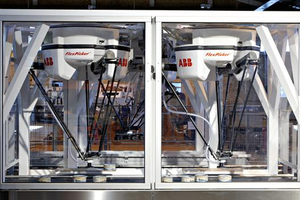
From pancakes to jelly beans, a new breed of intelligent robots are preparing our food, discovers Veronique Greenwood, and it can be a dazzling sight.
Last July, while touring a jelly bean factory, I came upon a startling sight. Over a conveyor belt, a large robot spider danced over packets of sweets, plucking each one up with human speed and precision and placing it in a carton. The packets were piled willy-nilly, but the machine and its colleagues – two others were also manning the line – seemed to know where each one was and worked together to collect them all in seconds. It was riveting, and not a little eerie.
It turns out these robots are based on a design by Swiss robotics professor Reymond Clavel of the Ecole Polytechnique Federal de Lausanne, called a delta robot. They are incredibly quick and can do jobs in food packaging that only humans used to be able to do, like sorting or stacking randomly arranged objects, without the repetitive stress injuries such tasks give people.
Automation in the food industry has moved far beyond the simple labelling machines and conveyor belts you may be familiar with. Now intelligent robotic arms perform dazzling movements and expert feats of coordination, getting everything from frozen fish chunks to cookies swiftly into their packaging. It's not a side of processed foods you see that much, but it is everywhere.
To find out more about how they work, I spoke to Klas Bengtsson, a product manager at ABB, a Swiss company which makes food-grabbing delta robots.
Here are the robots at work at a Honeytop Specialty Foods factory, with a soundtrack that sounds a bit “Mission: Impossible.
So what's going on in that pancake video? First, the pancakes go through a tunnel where a camera takes stock of where everything is lying on the conveyer belt. The camera feeds that information into software that records each pancake's location. If the food item in question isn't lying flat, says Bengtsson, there's a spot for the software to record its angle of placement as well.
The software feeds that information to the robot, which deploys its arm to that location, turns on a tiny vacuum on the end of the arm, and sucks up the pancake, gently but surely. It whirls around to the centre conveyer belt, where it puts the pancakes in piles to be packaged, turns off the vacuum to release its payload, and whirls right back out to intercept the next one. If it gets a bunch of pancakes too close together to stack all of them immediately, it deposits extras in a little tray above the conveyer to use in the future when the pancakes are more spread out.

The robot picks up the pancake with suction (ABB)
The Honeytop set-up has four robots spread out along the conveyor belt, so if one robot doesn't have time to grab all the pancakes in its view, another robot will. Overall the robotic team can stack more than 400 pancakes per minute. “There's a lot of deep-down technology to get this accurate,” Bengtsson says. “You have this expression once in a million, but when you are picking pancakes in a line like this, if you had a failure or a problem once in a million, that would be quite often.”
The salami video shows a tougher situation for the robots, says Bengtsson. Four of them are working right in each others' elbow room, thanks to space constraints in the factory, and they are grabbing the salami in small mechanical claws and depositing them on plastic sheeting that will be sealed up around them. The claws – each robot has three – have more moving parts than a vacuum, and timing their opening and closing is trickier than just turning a vacuum on and off. “I know this was a real challenge,” he says. “There are a lot of tricks in here.”

Adjacent robot arms coordinate their activity and can handle more than just food (ABB)
You can package food without such agile machines. But the benefit of having robots this fast and flexible is that you don't have to install machinery that will, say, make sure all of the salamis are lying straight and equidistant from each other. So you can use the same assembly line for salamis of one length in the morning and an inch longer in the afternoon, and all you have to swap out is the packaging, not the robots. The pancake stackers, too, can stack pancakes in short or tall stacks, in as many columns as needed, without just a little reprogramming.
This kind of super-adaptable packaging set-up isn't limited to a particular kind of product. Just about any object can be picked up and placed with these machines, and they can do other delicate food tasks, including scoring lines on bread before it is baked.
So while a fleet of delta robots isn't cheap to design or install, they are appearing more and more in industrial food settings. An uncanny intelligence was one of the last things to touch some of the products you can buy in packages – an interesting picture to have in your mind as you reach out to put them in your shopping basket.
http://www.bbc.com/future/story/20141209-the-food-robots-we-never-see
